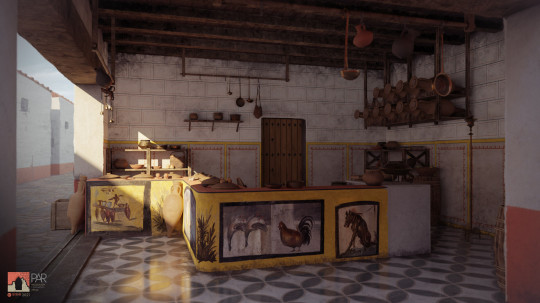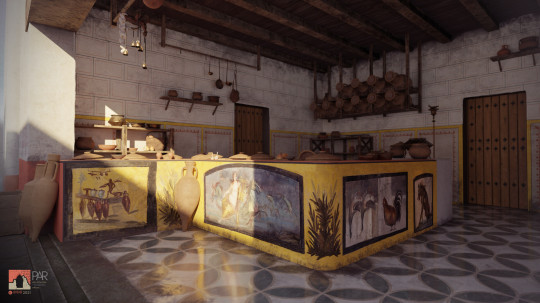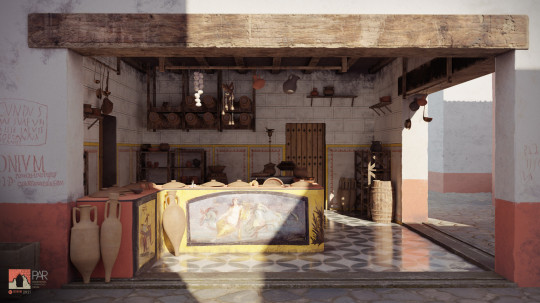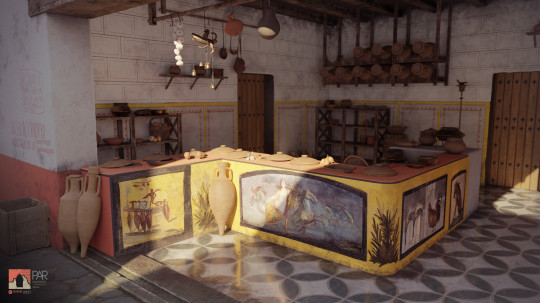#Thermopolia
Explore tagged Tumblr posts
Text

#thermopolia#ancient Rome#fast food#history#dining#Roman culture#archaeology#culinary history#Roman Empire#food culture
261 notes
·
View notes
Text
Something about "fast food"

During the period of the Greek invasion of Sicily, between the 8th and 6th centuries BCE, the settlers introduced new culinary traditions. In the Greek cities of the island, small eateries emerged that can be considered early versions of modern fast food. These establishments, called thermopolia, were shops located along main streets where ready-to-eat meals could be purchased to consume on-site or take away.
The thermopolia were characterized by stone counters that housed large jars used to store warm foods like soups, stews, and grains. The most popular dishes included barley bread, olives, dried figs, and local cheeses, often served with wine. This type of dining was especially convenient for merchants, craftsmen, and travelers, offering them a practical and affordable way to eat.
The cuisine of the thermopolia reflected a blend of Greek and Sicilian culinary traditions, combining local ingredients such as honey, almonds, and aromatic herbs with the flavors and techniques of Greek cooking. This model of fast dining demonstrates the cultural and everyday influence the Greeks had on the island.
This habit of eating on the go also became common in Roman times: in the tabernae, spectators of games in amphitheaters could buy food during the long days of entertainment.
#AncientFastFood#GreekInvasionSicily#Thermopolia#AncientCuisine#GreekSicilianFusion#StreetFoodHistory#RomanFoodCulture#FoodThroughHistory#SicilianTraditions#AncientEateries#CulinaryInfluence#GreekHeritage#FastFoodOrigins#FoodOfThePast#SicilianHistory
2 notes
·
View notes
Text


Suggestober 8: Hopeful for a snack
206 notes
·
View notes
Text
Tavern (popina or caupona) and/or eatery (thermopolia) fresco scenes from Pompeii.

Probably at a thermopolium, two pair of people are sitting down to eat. There's possibly a child standing on the right, or it might be a slave, who were depicted small to visually represent their relative societal un-importance. Note the nice detail of the hanging rail above with sausages, just as you see in shops in Italy today.

Here, a man is probably paying a landlord for a beaker of drink, though perhaps he's just purchased nuts or seeds in a cup. It's probably that which was stored in the inset jars you see in thermopolia counters, while the hot food would almost certainly have been kept on the hob behind the counter (example below, also at Pompeii).


Two men play at dice with spectators. Dice was outlawed at various times in the Roman world, but there is little doubt it went on anyway in the back rooms of cauponae.
[Photos are my original photography. Please do not save and repost - reblogging is fine.]
188 notes
·
View notes
Text
You know how a waffle house index can sometimes be used to gauge the severity of natural disasters and disruption to the surrounding area? There's something similar for supernatural disasters.
Indeed, there is a supernatural eatery that is open during crises up to the severity of Ragnarok, Armageddon, descent of Kalki, the end of the Fifth World, etc.
This establishment has no name. You'll probably perceive it as something familiar to you. A fast food restaurant now, a cafe or a tavern, and in the ancient world people may have seen popinae, thermopolia, or a line of street sellers when none would be working.
This is because like the temple, for most of sedentary human history the public eatery has been been 1) a necessity when people gather in any density and 2) an in-between place for the human body as well as the human imagination. The public eating place serves as a hearth for those who are away from home, or for those whose home cannot support a hearth.
During a disaster, many people cannot return to their homes. This is true naturally, so it is also true supernaturally. Only, you don't overlap with the supernatural very much in ordinary circumstances.
One way to tell if you are sheltering outside of the mundane is if the menu seems strange to you. This can be difficult to notice as your 'normal' has been disrupted, but you might try to order at a diner only to see 'Riddle Cakes', or 'Eggs Over.' Over toast? Over easy? They're over, that's what matters.
Walking in, the 'no shirt/no shoes' sign may feature a clothed figure: the shirt is inside-out instead of missing. You shouldn't count the fingers of the one to take your order and you shouldn't make eye contact with other diners to avoid a scene, but the food will be safe to eat and you will be allowed to leave in peace.
if this establishment is not open, it is safe to say that this version of the world has really ended, and you probably will not be around to witness its dark, locked doors. Ask a more agreeable God about this, and it's a fair chance they will laugh and say that actually, you are the one thing that will remain open through all but the worst times.
12 notes
·
View notes
Text
curious how there are many pop songs lately where fast food is a metaphor for sex. and yet nobody is writing about buying escargot at the thermopolia of ancient rome as a metaphor for sex. 🧐
13 notes
·
View notes
Text
Bring back themed restaurants. Like Rainforest Cafe. You know how much I love Rainforest Cafe?
There is a restaurant a couple hours away themed off a WORLD WAR II BUNKER. They've become uppity and overpriced for essentially bar food unfortunately.
I want a restaurant themed after Ancient Rome thermopolia, with pre Columbian exchange accurate cultural foods.
I want to eat in a dilapidated Arctic outpost.
Or in a dragon's lair. Lots of barbecue for THAT menu
4 notes
·
View notes
Text

Xanthippe of Themyscira
Xanthippe is an Amazonian with an unquenchable thirst for knowledge and a dangerous curiosity that has put her life in danger on more than a few occasions.
Though an accomplished warrior, once Themyscira retreated from the world of Man, Xanthippe found herself plagued by thoughts of what might be happening beyond the island's shores (what wars did she miss? Were any new foods being sold at thermopolia? Had she missed the publishing of any epics written by women??).
It distracted her on the daily, earning her a few scars in practice spars with fellow Amazons who expected her to stay focused and earning her repeated lectures from her sisters. Often, she was given an overnight rotation of guard duty at the temple to Apollo as a punishment, but this only allowed her to look up at the stars and ponder her questions unchallenged.
One night - fresh off of another lecture and nursing her bruised arm and ego - Xanthippe rhetorically asked the statue of Apollo what she had done to be 'cursed' with such a wandering mind…and Apollo responded.
The god of oracles, music, and knowledge dropped several large surprises on Xanthippe at once, those being that he was her father, the world was going to end in twenty hours, and that she was the subject of a prophecy he’d made himself when she was born and was thus destined to save the world with the help of a great warrior. Before Xanthippe could ask many (or really any) questions (why her? Was she hallucinating? Is this why her mother had pushed so hard for her to pick up the lyre??) Apollo summoned this other warrior and sent them both on a quest across time to find and recover an artifact of Aion, with only their only warning being that her only way back to Themyscira was to succeed…or die trying.
Over the course of this quest, Xanthippe and the other hero - a spirit named ‘Gawain’ - befriended one another through late-night therapy around campfires, commiserating over the burden of having responsibility thrust upon you with no warning, and trading knowledge. Xanthippe was ecstatic to learn that not only was Gawain from the world of Man but he was from the future, and he was more than happy to trade her answers for stories of of war and romance from her own time. She was less enthused to learn that he was still a child…the realization that this boy had died before reaching adulthood and yet still had to carry the burden of his family’s curse through his afterlife instead of resting made her re-evaluate her initial opinion o him (which was. Not good. Gawain fell flat on his face and his helmet popped off and Apollo didn’t really help and it was a whole Thing.).
They were successful in their quest to retrieve the artifact and stop the madman who had plotted to use it to change the outcome of the Trojan War, but Xanthippe hesitated to return to Themyscira. She’d enjoyed her time beyond the island’s shores and didn’t want to return to a life of simply wondering, now that she knew how much knowledge still awaited her around the world. Apollo insisted she had to return to the island to fulfill the prophecy, but softened the blow with a promise that she would, in her own future, travel to the world of Man again. Gawain told her to look him up if she was ever in ‘Texas’, and they parted ways with the power of Apollo.
Having returned only a few minutes after she had departed, Xanthippe told no-one of her overnight quest, and her focus improved, now that she had reassurance that knowledge from the lands beyond the horizon were not going to be out of her reach forever. Her sisters assumed that the overnight guard shifts had finally worked some sense into her, but Xanthippe continued to volunteer for them over the centuries (they gave her more time to talk with her father, after all). She waited for three thousand years, slowly losing hope as time marched on and nothing changed, and the gods slowly began to grow quiet…and then, with a thunderous crash, the Imperium came to Earth, and Apollo appeared in her dreams to let her know it was almost time.
When Themyscira began to slowly reach out to the wider world with princess Diana as their ambassador, Xanthippe accompanied her as part of an introductory entourage to the UN. Having heard the tales of Diana’s time-traveling adventures with the Justice League, Xanthippe shared her own, and pled her case to stay in man’s world beyond the timeframe of the diplomatic mission - both to finally satiate her burning thirst for knowledge but also to look for her friend.
#[[Themyscira Dreamer]] - Xanthippe#((guarantee Gawain has called her 'Xanna-banana' at least twice))#((she is the Responsible Adult in matters of combat and nowhere else))#((Wonder Woman does eventually forgive the lasso of truth/magic spaghetti incident))#((but I wanted to give Gawain an Amazonian mentor who didn't start out with some sort of a grudge against him))
3 notes
·
View notes
Text


In 2020, archaeologists announced the discovery of the Thermopolium of Regio V, one of the oldest snack bars at Pompeii.
It was a sort of ancient 'fast food' counter which sold ready-to-eat food.
Thermopolia were popular among the working classes and those who could not afford a private kitchen. Here customers could choose from a selection of ready-made dishes, kept warm in jars that were set into a counter.
Archaeologists have discovered an inlaid marble floor, pots and have even clues about what was on the menu - in one of the heated clay pots a residue of one 'paella-type dish including a mixture of mammals, birds, fish and snails', was discovered.
Reconstruction by PAR. Arqueología y Patrimonio Virtual
Photo by: Luigi Spina
2 notes
·
View notes
Photo

Romans had their own version of fast food known as a "thermopolium." These ancient eateries were a fascinating glimpse into the culinary habits of the time. A Roman thermopolium was essentially an early form of a fast-food joint. It was a place where people could enjoy hot food and drinks on the go. What made them unique was their setup. At the heart of a thermopolium was a counter, and embedded in this counter were containers called "dolia." These dolia held a variety of dishes, from stews to sausages to simple snacks. The concept was simple and effective. Patrons could quickly purchase ready-made meals from these dolia, making it a convenient option, especially for the working class. It was like a precursor to today's fast-food restaurants, where people could grab a quick, satisfying bite to eat during their busy days. Roman thermopolia were not only places to satiate one's hunger but also hubs of social activity. People from different walks of life would gather around these counters, sharing stories and enjoying the diverse flavors of ancient Roman cuisine.
4 notes
·
View notes
Photo
I've been to Pompeii twice and I say it's a crime they haven't done such a restoration irl of one of the thermopolia to cater to today's visitors.





Virtual reconstruction of the thermopolium discovered during the last excavations in Pompeii. Made by the Spanish archaeologist Pablo Aparicio Resco, based on original photographs by Luigi Spina / Parco Archeologico di Pompei.
Note: “Thermopolium” is a popular word created by the archaeologists; there was no such word in Latin, the actual word is Caupona; the modern equivalent of Restaurant, and at the same time Cafe/Bar and fast food stall.
4K notes
·
View notes
Text
Word Cited
Cartwright, Mark. “Library of Celsus.” World History Encyclopedia, November 26, 2024. https://www.worldhistory.org/Library_of_Celsus/.
“Colosseum.” Britannica, November 23, 2024. https://www.britannica.com/topic/Colosseum.
kjw2. “Baths & Bathing as an Ancient Roman.” View page: Baths & Bathing as an ancient roman. Accessed November 26, 2024. https://depts.washington.edu/hrome/Authors/kjw2/BathsBathinginAncientRome/245/pub_zbpage_view.html.
Moore, Stan. “St. Peter’s Basilica.” St. Peter ’s Basilica. Accessed November 27, 2024.
https://core.ac.uk/download/pdf/232828448.pdf.
Roberts, Canon. “Titus Livius (Livy), the History of Rome, Book 1 Rev. Canon Roberts, Ed.” Titus Livius (Livy), The History of Rome, Book 1, chapter pr. Accessed November 26, 2024. https://www.perseus.tufts.edu/hopper/text?doc=Perseus%3Atext%3A1999.02.0026.
Simkin, John. “The Roman Games.” Spartacus Educational. Accessed November 26, 2024. https://spartacus-educational.com/ROMgames.htm.
Sullivan, Mary Ann. “Mausoleum of Hadrian.” Images of the mausoleum of hadrian (or Castel Sant’Angelo), 135-39 C. E., Rome. Accessed November 26, 2024. https://homepages.bluffton.edu/~sullivanm/castelsa/castelsa.html.
“Terme Del Foro - Planet Pompeii.” www.planetpompeii.com. Accessed November 26, 2024. https://www.planetpompeii.com/en/map/forum-baths.html.
“Thermopolia: The Street Food of Ancient Pompeii.” Pompeii Archaeological Park, January 5, 2024. https://pompeiiarchaeologicalpark.com/thermopolia-street-food/.
“Thermopolium.” Pompeii Sites, October 31, 2023. https://pompeiisites.org/en/archaeological-site/thermopolium/.
0 notes
Text
3. Steden
Met de opkomst van grotere nederzettingen, handelsroutes en de groei van deze stadscentra kwam er een belangrijke ontwikkeling in de geschiedenis van de gastronomie, die de manieren van voedselproductie, -distributie en -consumptie veranderde. Naarmate steden zich uitbreidden, nam ook de complexiteit van stedelijke voedselsystemen toe en ontstonden er nieuwe culinaire innovaties en eetgelegenheden.
Naarmate de stedelijke bevolking groeide, nam de vraag naar voedsel toe, waardoor efficiëntere landbouwpraktijken en distributienetwerken nodig werden. Een voorbeeld hiervan is de opkomst van stedelijke markten. Boeren op het omliggende platteland begonnen zich te specialiseren in gewassen en vee die verkocht konden worden op deze vroege handelsplaatsen.[1]
Stedelijke markten werden centrale knooppunten voor voedseldistributie en boden een breed scala aan producten van zowel lokale als verre bronnen. Deze markten waren een centrale plaats voor alles gerelateerd aan voedsel, en opende de deur voor uitwisseling van culinaire gebruiken en ingrediënten. Vroege stedelingen werden blootgesteld aan nieuwe smaken en kooktechnieken.[2][3]
Handelsroutes verbonden steden met elkaar, en breidden het aanbod van beschikbare ingrediënten verder uit. Over verloop van tijd werden kruiden, exotisch fruit en buitenlandse delicatessen steeds toegankelijker, zij het vaak tegen hoge prijzen.[4]
Met de groei van steden ontstond ook de behoefte aan gemakkelijke voedselopties voor reizigers, handelaren en stedelingen zonder toegang tot een eigen keuken. Oude beschavingen zagen de opkomst van straatverkopers, thermopolia in Rome[5] en theehuizen in en rond China,[6] die dienden als voorlopers van moderne restaurants. Deze vroege eetgelegenheden richtten zich op verschillende sociale klassen en speelden een belangrijke rol in de stadservaring. In het middeleeuwse Europa verschenen er steeds meer tavernes en herbergen, die eenvoudige gerechten en gemeenschappelijke eetervaringen aanboden. Hoewel deze plekken nog niet helemaal leken op moderne restaurants, waren ze essentieel bij het vormgeven van het concept van uit eten gaan.
Het concept van openbare eetgelegenheden heeft dus eeuwenoude wortels. Er werd in verschillende plaatsen eeuwenlang eten geserveerd. Echter, het moderne restaurant zoals we het nu kennen, ontstond in het 18e-eeuwse Parijs. In 1765 opende een soepverkoper genaamd Boulanger wat beschouwd wordt als het eerste echte restaurant, met een menu van herstellende bouillons of ‘’restaurants’’ voor klanten.[7]
Dit nieuwe eetconcept werd al snel populair en biedt een aantal belangrijke innovaties;[8]
Individuele tafels en privé-eetruimtes
Menu’s met verschillende opties en prijzen
Vaste openingstijden
Professionele koks en bedienend personeel
Het nieuwe restaurantmodel verspreidde zich snel door Europa en daarbuiten, waarbij het zich aanpaste aan lokale smaken en gewoonten. In de 19e eeuw stimuleerde de Industriële Revolutie de groei van steden en de middenklasse, waardoor er een groter clientelle voor restaurants ontstond. Mensen van verschillende afkomst en bevolkingsgroepen begonnen zich in steden te vestigen, en brachten ook hun culinaire gewoontes met zich mee. Hierdoor werden stedelijke centra broedplaatsen voor culinaire innovatie.
De opkomst van restaurants en de samenkomst van culturen bood koks een basis voor experimenten met nieuwe gerechten en presentatiestijlen. Ook ontstonden er in deze tijd culinaire scholen die kooktechnieken leerden en vastlegden.
[1] L. Civitello, Cuisine and Culture: A History of Food and People, h. 1.
[2] J. Pilcher, Food in World History,
[3] P. Frankopan, The Earth Transformed, p. 112-115, 277.
[4] L. Civitello, Cuisine and Culture: A History of Food and People, p. 24, 80.
[5] C. Holleran, Finding Commerce: The Taberna and the Identification of Roman Commercial Space, p. 147.
[6] V. Sartor, All the Tea in China: The Political Impact of Tea, p. 185.
[7] R. Spang, The Invention of the Restaurant, Introduction.
[8] Idem, Preface, h. 5.
0 notes
Text
El primer restaurante de la historia
Los restaurantes se inventaron en Francia y el primero se remonta al año 1765. Fran Navarro Historiador y experto en documentación Los establecimientos que venden comida existen desde los orígenes de la civilización. Los romanos extendieron por todo el imperio el uso de locales como los thermopolia, donde se vendía comida caliente, y también estaban las posadas medievales, que tienen cierta…

View On WordPress
#Autor Fran Navarro#Civilizaciones#Francia 1765#Imperios#Madrid#Muy interesante .es#Pompeya#Primer restaurante#Siglo XIX
0 notes
Note
Recently found out about thermopolia, places in ancient rome where you could buy quick and easy take-out food or the roman version of fastfood. And I can't help but wonder what each of the Scrolls races would sell at their own thermopolia.
I'm of the opinion that Tamriel would grind to a halt without quick foods to keep us going. Every Province of course has its own specialties, but these are some of the most popular snacks you have to try!
Altmer
Eating on the go is difficult to manage in Summerset. After all, eating with your hands is uncouth, so what is one to do? Ricepaper-wrapped salads are a staple for healthy eating when pressed for time, and can contain any number of ingredients one likes. Common fillings for these ricepaper rolls include lettuce, shredded carrots and cucumber, sweet shrimp, cold roast chicken, and tahini.
Argonians
While Argonians prefer to sit down for a meal with friends and family, sometimes it's necessary to grab a bite before heading into the swamp. Saltrice steamed in banana leaf packages with tasty ingredients on the side makes the ideal portable meal. Each package is water-tight and contains just enough for a single meal, while the banana leaf imparts a great aroma on the saltrice. For something similar, why not try my Blackwood Stuffed Banana Leaves?
Bosmer
Out of all the races, the Wood Elves have truly mastered the art of quick and easy foods to eat on the road. While it's less appetising than other snacks, pemmican, a type of dried meat and tallow patty, is great for filling your belly when you don't have the time for a meal. It can be eaten as is, or is sometimes pre-fried to make a crunchy, meaty snack. More interesting than jerky, and quite nutritious too!
Bretons
High Rock is renowned for its excellent inns, and many of them cater to travellers needing a quick bite to eat. Hot pies and pasties are a Provincial favourite, and they are usually filled with meat and vegetables, though plenty of other variants exist. When I'm in High Rock, I spend a lot of time eating my favourite steak, cheese and onion pasties, or a good steak pie with mushy peas on the side.
Dunmer
Dunmeri traders and travellers for centuries swear by wickwheat rolls, which are soft rolls that are a bit like a cross between puff pastry and rye bread. These rolls are baked with fillings and are easy to bring around with you, and taste great regardless of their temperature. One of the most common variants is a chunky mix of scuttle, hackle-lo leaf, and nix-hound meat paste, which is seasoned with a good amount of herbs and spices. It's meaty and creamy, and sure to keep you sated for some time.
Imperials
There are so many types of snack foods in Cyrodiil that it would take a day and a half to list all of them, but out of all of them, fried bread sandwiches are probably the most common and popular due to their versatility. These aren't sandwiches per se, but are pockets of bread that are flash fried in olive oil after being stuffed with ingredients like cured meats, cheese, tomatoes, and peppers. They are usually served with a topping of fresh salad and shaved pecorino.
Khajiit
Rice rolls, rice rolls, we love rice rolls! These wonderful snacks are easily portable, making them the ideal meal on the go, and they taste great hot or cold too. Fresh fish, vegetables, pickled spicy cabbage, and grilled meat are among the fillings you'll find tightly wrapped in a sizeable tube of seasoned brown rice, which is wrapped again in nori to hold the tube together. Filling and delicious!
Nords
There's nothing better than a fresh hot waffle on a cold day...except for a freshly grilled horker sausage or rabbit meatballs wrapped in a waffle, with a good spoonful of crispy fried onions, juniper berry relish, and strong wholegrain mustard. Eating these gracefully is an impossible task, so remember to pack napkins!
Orcs
Most Orcs prefer sitting down to a meal than a quick lunch on the go, but if you're heading out the door, it doesn't hurt to pack a potato croquette or two. Mashed potato is patted around meat and diced radishes, rolled in panko breadcrumbs, and deep fried until crispy. These greasy treats stay warm for ages when packed in metal lunchboxes, so they're ideal for travellers.
Redguards
The Redguards use folded cactus skins to make takeaway boxes, and their watertight properties mean that it's possible to pack soups quickly and easily for eating on the go. A goat meatball stew drizzled with yoghurt and honey is a nomad's favourite dish as it contains all the nutrition you need to stay alive in the inhospitable Alik'r for extended periods of time. The lid also acts as a way to eat your soup without sand getting in- just slurp it through a straw! You can also try my Pack Guar Pide for a Hammerfell-style street food favourite!
#Asks#Thermopolia#Food#Fast food#Tes#The Elder Scrolls#world building#worldbuilding#Tastes of Tamriel#tastesoftamriel#Recipe#Recipes#Cooking
448 notes
·
View notes
Text
2,000-Year-Old Fast Food Shop Uncovered in Pompeii

Archaeologists have unearthed a frescoed thermopolium (a hot-food-drink shop) in Pompeii, an ancient Roman city frozen in time after the catastrophic eruption of Mount Vesuvius in 79 CE.
“Thermopolia, where drinks and hot foods were served and stored in large dolia (jars) embedded in the masonry counter, were widespread in the Roman world, where it was typical to consume the prandium (the meal) outside the house. In Pompeii alone there are 80 thermopolia,” Dr. Massimo Osanna, interim director general of the Parco Archeologico di Pompei, and colleagues said in a statement.
“As well as being another insight into daily life at Pompeii, the possibilities for study of the newly-discovered thermopolium are exceptional, because for the first time an area of this type has been excavated in its entirety, and it has been possible to carry out all the analyses that today’s technology permits.” Read more.
2K notes
·
View notes